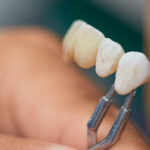Are you experiencing a fleeting twinge when you sip your morning coffee or a dull ache after indulging in a sweet treat? Perhaps you’ve noticed a new, persistent sensitivity to cold air or a subtle discoloration on one of your teeth. These seemingly minor discomforts are often dismissed as fleeting annoyances, but they could be your mouth’s way of signaling a silent threat: a cavity.
Cavities, also known as dental caries, are one of the most common chronic diseases globally, affecting people of all ages. They are essentially permanent damage to the hard surface of your teeth, forming tiny holes or openings. Left untreated, these holes can grow larger, leading to severe pain, infection, and even tooth loss. The tricky part? In their earliest stages, cavities often present with no symptoms at all, making regular dental check-ups incredibly important. However, as they progress, your body will start sending signals.
This comprehensive guide will help you understand and recognize the various cavity symptoms, from the subtle whispers of early decay to the undeniable cries of advanced infection. By arming yourself with this knowledge, you can take proactive steps to protect your oral health and seek timely treatment. And when it comes to expert care and lasting solutions, Madison Dentistry & Implant Center stands ready to be your trusted partner in maintaining a healthy, radiant smile.
The Early Warning Signs – Subtle Cavity Symptoms You Shouldn’t Ignore
Catching a cavity in its nascent stages is key to simpler, less invasive treatment and preventing further damage. While they might be easy to overlook, these early warning signs are your first clues.
Tooth Sensitivity: More Than Just a Chill
One of the most common early indicators of a cavity is increased tooth sensitivity. You might notice a sharp, sudden pain or a mild discomfort when your teeth are exposed to:
- Hot or cold temperatures: Sips of hot soup, cold water, or even breathing in cold air can trigger a reaction.
- Sweet foods and drinks: Candies, sodas, and even some fruits can cause a noticeable twinge.
- Acidic foods: Citrus fruits, vinegar, and certain sauces might elicit discomfort.
This sensitivity occurs because the protective enamel layer of your tooth has been compromised by decay, exposing the underlying dentin. Dentin contains thousands of microscopic tubules that lead directly to the tooth’s nerve. When these tubules are exposed, external stimuli can irritate the nerve, causing pain. It’s crucial to differentiate this from general sensitivity caused by receding gums or aggressive brushing; cavity-related sensitivity is often localized to a specific tooth or area. If a particular tooth consistently reacts to temperature changes or sweets, it’s time to investigate.
Stains on Your Tooth Surface: A Visual Clue
While not all stains indicate a cavity, changes in the color or appearance of your tooth enamel can certainly be a red flag. Look for:
- Brown or black spots: These are often visible on the chewing surfaces of back teeth or between teeth.
- White spots: In some early cases, a cavity might appear as a chalky white spot, indicating demineralization of the enamel. This is a sign that the enamel is weakening before a visible hole forms.
It’s easy to dismiss a new spot as just a coffee stain, but don’t let cosmetic concerns overshadow potential health issues. A friend of mine, Sarah, noticed a small brown speck on one of her molars but thought little of it. Months later, it had deepened, and she started experiencing sensitivity. Turns out, it was an early cavity that could have been addressed much sooner if she hadn’t waited. A thorough dental examination can easily distinguish between a harmless stain and the beginning of decay.
Mild to Moderate Pain When Eating or Drinking: The Initial Discomfort
Beyond sensitivity, a mild, fleeting pain that occurs specifically when you bite down or chew on certain foods can signal a developing cavity. This discomfort might not be constant and could even disappear quickly, but it’s your tooth reacting to the pressure of chewing on an area where enamel has weakened. Pay attention to which teeth feel “off” when you’re eating; even minor, intermittent pain is a signal from your body that something isn’t right and warrants professional attention.
As Cavities Progress – Unmistakable Symptoms
If the early warning signs are missed or ignored, cavities will inevitably grow larger and deeper, leading to more pronounced and persistent symptoms.
Sharp Pain When Biting Down: A Clear Indication of Deeper Decay
As a cavity progresses, the compromised tooth structure can no longer withstand the normal forces of biting and chewing. You might experience a sharp, distinct pain when you bite down directly on the affected tooth or if food gets lodged in the decaying area. This often signifies that the decay has gone beyond the outer enamel layer and has started to affect the softer dentin, which is closer to the tooth’s nerve. The pain can be quite intense and can linger for a short period even after you stop biting.
Visible Holes or Pits in Your Teeth: The Obvious Sign
In more advanced stages, you might actually be able to see a physical hole or pit in your tooth. These can range from a small, dark depression to a larger, noticeable opening. You might even feel the hole with your tongue. While a visible hole is an undeniable sign of a cavity, waiting for this symptom means the decay is already significant and may require more extensive treatment. Regularly examining your teeth in a good light can help you spot these changes early.
Bad Breath (Halitosis) and Unpleasant Taste: Bacterial Byproducts
Cavities create an ideal environment for bacteria to thrive. Food particles can easily get trapped within the decay, leading to an accumulation of bacteria and their waste products. This bacterial activity and the decomposition of food can result in:
- Persistent bad breath (halitosis): Even with regular brushing and flossing, if you have an untreated cavity, you might struggle with chronic bad breath.
- An unpleasant taste in your mouth: You might notice a foul or metallic taste that lingers, especially near the affected tooth.
These symptoms are a clear indication that bacterial activity is rampant and the decay is progressing, impacting not just your oral health but also your social interactions.
Constant, Spontaneous Toothache: No Longer Just a Reaction
A constant, throbbing, or spontaneous toothache, especially one that worsens at night or is not triggered by external stimuli, is a strong indicator that the decay has reached the tooth’s pulp. This signifies pulp inflammation (pulpitis) or even infection. The pain can be excruciating and might radiate to your jaw, ear, or temple. Over-the-counter pain relievers might offer temporary relief, but they won’t address the underlying infection. This level of pain demands urgent dental care.
Swelling Around the Tooth or Gums: Abscess Formation
If the infection within the tooth pulp spreads beyond the tooth tip and into the surrounding bone and gum tissue, it can lead to the formation of a dental abscess. An abscess is a pocket of pus caused by a bacterial infection. Signs of an abscess include:
- Swelling: Noticeable swelling in the gum tissue around the affected tooth, or even swelling in the cheek or jaw.
- Tenderness: The swollen area will likely be very tender to the touch.
- Pimple-like bump: Sometimes, a small, red, pimple-like bump might appear on the gum near the root of the tooth; this is a fistula, allowing pus to drain.
A dental abscess is a serious condition that requires immediate treatment to prevent the infection from spreading further into your face, jaw, or even other parts of your body.
Fever: A Systemic Response to Infection
In severe cases, when a dental infection is significant and spreading, your body’s immune system might react with a systemic response, leading to a fever. If you experience a fever in conjunction with severe tooth pain, swelling, or pus, it indicates that the infection is no longer localized and could be impacting your overall health. This is a medical emergency that requires immediate attention from a dentist or medical professional.
Prevention Strategies
- Brush and Floss Properly: Brush your teeth at least twice a day for two minutes each time with a fluoride toothpaste, and floss daily to remove plaque and food particles from between teeth and along the gumline.
- Mind Your Diet: Limit sugary and acidic foods and drinks. If you do consume them, try to do so with meals rather than throughout the day, and rinse your mouth with water afterward.
- Regular Dental Check-ups and Cleanings: This is paramount! Professional cleanings remove hardened plaque (tartar) that brushing can’t, and your dentist can spot and address early signs of decay before they become major problems. Madison Dentistry & Implant Center emphasizes proactive preventive care.
- Fluoride Treatments and Sealants: Your dentist may recommend professional fluoride treatments to strengthen enamel, especially if you’re cavity-prone. Dental sealants can also be applied to the chewing surfaces of back teeth to provide a protective barrier against decay.
Your Partner in Oral Health – How Madison Dentistry & Implant Center Can Help
At Madison Dentistry & Implant Center, we understand that your oral health is intrinsically linked to your overall well-being. If you’re experiencing any of the cavity symptoms described in this guide, or if it’s simply time for your routine check-up, our dedicated team is here to provide exceptional care.
- Comprehensive Diagnostics: We utilize advanced diagnostic tools, including digital X-rays and intraoral cameras, to accurately detect cavities, even in their earliest stages, ensuring a precise diagnosis.
- Personalized Treatment Options for Cavities:
- Fillings: For smaller cavities, we offer various filling materials, including tooth-colored composite resins that blend seamlessly with your natural teeth, as well as durable amalgam fillings.
- Crowns: If a cavity is too large for a filling and has weakened a significant portion of the tooth, a dental crown may be recommended to restore its strength, shape, and appearance.
- Root Canals: When decay reaches the tooth’s pulp and causes infection, a root canal procedure can remove the infected pulp, save the natural tooth, and alleviate pain.
- Extractions: As a last resort, if a tooth is severely damaged beyond repair, extraction might be necessary, followed by discussions about replacement options like dental implants or bridges.
- Personalized Care and Prevention Plans: Beyond treating existing issues, we focus on helping you prevent future problems. Our team will work with you to develop a customized oral hygiene routine, provide dietary guidance, and recommend preventive treatments tailored to your unique needs.
- The Madison Dentistry Difference: Our experienced dentists and compassionate team are committed to providing patient-centered care in a comfortable and welcoming environment. We combine state-of-the-art technology with a gentle approach, ensuring you receive the highest standard of dental treatment. Your comfort and peace of mind are our top priorities.
Protect Your Smile – Don’t Let Cavities Win
Cavities might be a common dental problem, but they don’t have to define your oral health journey. By understanding the signs and symptoms, from the subtle sensitivity to the more urgent pain and swelling, you empower yourself to act early. Remember, early detection means simpler, less invasive, and more affordable treatment.
Don’t let a “silent threat” compromise your smile or your well-being. Prioritize regular dental check-ups and maintain excellent oral hygiene habits. If you suspect you have a cavity or are experiencing any of these symptoms, don’t delay! Contact Madison Dentistry & Implant Center today to schedule your comprehensive dental exam. Let us help you keep your smile healthy, strong, and beautiful for years to come.




